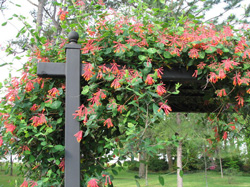Resource Library
Plant of the Week: Trumpet Honeysuckle
The University of Arkansas System Division of Agriculture does not promote, support or recommend plants featured in "Plant of the Week." Please consult your local Extension office for plants suitable for your region.
Plant of the Week
Trumpet Honeysuckle
Latin: Lonicera sempervirens

Got hummingbirds? Want them? Plant a trumpet honeysuckle.
Trumpet honeysuckle (Lonicera sempervirens) has flowers designed for hummingbirds, and if there are any around when it blooms, they're sure to find it. And, once they find your garden, they might just want to hang out the rest of the summer, if you have other flowers to attract their attention.
Trumpet honeysuckle is a twining deciduous vine native throughout most of the eastern half of the country, but is most common in the wild in the southeastern states. Linnaeus gave it the name "sempervirens," which means evergreen in Latin but in reality it is only evergreen in areas with very mild winters. As vines go, it's only moderately vigorous, growing to 10 or 15 feet tall. It's more rampant than clematis but almost timid when compared to aggressive vines such as Japanese honeysuckle, akebia or wisteria.
Trumpet honeysuckle produces different shaped leaves on the vine. Lower leaves appear early in the season and are oval in outline with a quarter-inch-long petiole. These turn from bright green to blue green as the season progresses. The pair or two of leaves just below the inflorescence are fused at the base and surround the stem in a unique manner.
The flowers appear in April and May and are borne in many-flowered terminal clusters. The long, narrow tubular flowers are to two inches long and flare to five lobes at the end tube with the lower lobe slightly larger. The outside of the tube is usually red with the inside yellow or orange; nurserymen sometimes offer orange- and yellow-flowered selections. Red fleshy berries are sometimes produced but birds do not easily spread this species as they do Japanese honeysuckle.
Though trumpet honeysuckle comes from an oft-fragrant clan, this species lacks fragrance. Alice Coats, writing in her 1964 Garden Shrubs and their Histories, says of this non-fragrant species, "a honeysuckle without a scent is like a man without a shadow."
The trumpet honeysuckle was introduced into England by John Tradescant the younger (1608 - 1662) who visited Virginia from 1628 to 1637. He was the first person to directly collect plants in North America. Following the death of his father he became the head gardener to Charles I. Both Tradescants were collectors of natural history items and relics of the New World. These items were assembled into a bizarre collection called Museum Tradescantianum that remains largely intact at the Ashmolean Museum in Oxford.
Trumpet honeysuckle needs a trellis or fence on which to climb. It climbs by twining around its support and lacks the holdfasts found on climbers such as English ivy or trumpet vine. It can also be grown on open shrubs or allowed to scamper across the ground to create a kind of lumpy groundcover.
It's hardy from zone 4 to 9, where it grows in any decent garden soil. Flowering is best in full sun, but the foliage becomes tattered and worn by late summer in more exposed locations. It will grow in even heavy shade, but flowering will be reduced. Prune as needed after flowering to control shape and spread of the vine.
By: Gerald Klingaman, retired
Extension Horticulturist - Ornamentals
Extension News - June 6, 2008
The University of Arkansas System Division of Agriculture does not maintain lists of retail outlets where these plants can be purchased. Please check your local nursery or other retail outlets to ask about the availability of these plants for your growing area.